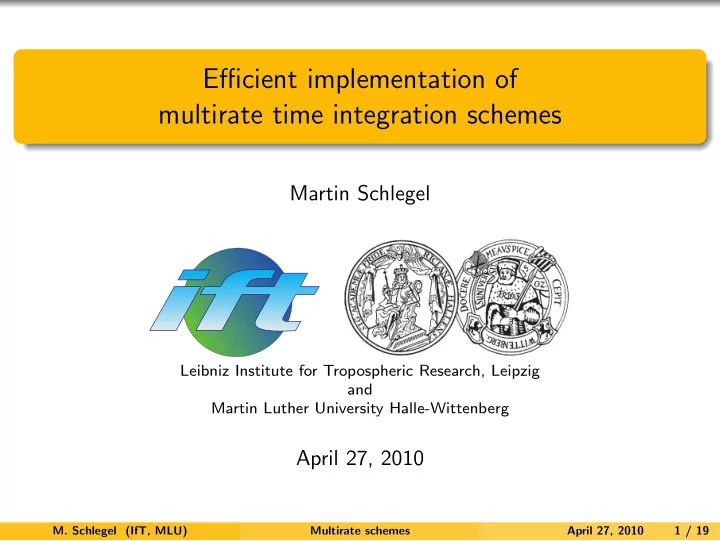

Efficient implementation of multirate time integration schemes Martin Schlegel Leibniz Institute for Tropospheric Research, Leipzig and Martin Luther University Halle-Wittenberg April 27, 2010 M. Schlegel (IfT, MLU) Multirate schemes April 27, 2010 1 / 19
Contents 1 Motivation 2 Time integration 3 Spatial discretization 4 Implementation Issues Time integration Data Exchange Parallelization issues 5 Simulation Results Academic example Real Example 6 Conclusions and Outlook M. Schlegel (IfT, MLU) Multirate schemes April 27, 2010 2 / 19
Motivation – MUSCAT Mu lti Sc ale A tmospheric T ransport model System for air pollution modeling Allows for complex simulations of atmospheric chemistry Online coupling to weather model possible Employs local refinement techniques Implementation basis: Written in Fortran 90/95 Communication via MPI Balancing via Metis/Parmetis M. Schlegel (IfT, MLU) Multirate schemes April 27, 2010 3 / 19
Motivation – MUSCAT (cont.) Local refinement M. Schlegel (IfT, MLU) Multirate schemes April 27, 2010 4 / 19
1 Motivation 2 Time integration 3 Spatial discretization 4 Implementation Issues Time integration Data Exchange Parallelization issues 5 Simulation Results Academic example Real Example 6 Conclusions and Outlook M. Schlegel (IfT, MLU) Multirate schemes April 27, 2010 5 / 19
Splitting of the RHS System to solve: ∂w ∂t = G ( w ) + F ( w ) � �� � nonstiff w 1 = w ( t n ) i − 1 � r i = ( a ij − a i − 1 ,j ) G ( w j ) j =1 v i ( c i − 1 ∆ t ) = w i − 1 ∂v i 1 = r i + F ( v i ) , τ ∈ [ c i − 1 ∆ t, c i ∆ t ] , i = 2 , ..., s + 1 ∂τ c i − c i − 1 = v i ( c i ∆ t ) w i w ( t n + ∆ t ) = w s +1 M. Schlegel (IfT, MLU) Multirate schemes April 27, 2010 6 / 19
Splitting of the RHS w 1 = w ( t n ) i − 1 � = ( a ij − a i − 1 ,j ) G ( w j ) r i j =1 v i ( c i − 1 ∆ t ) = w i − 1 1 ∂v i = r i + F ( v i ) , τ ∈ [ c i − 1 ∆ t, c i ∆ t ] , i = 2 , ..., s + 1 ∂τ c i − c i − 1 w i = v i ( c i ∆ t ) w ( t n + ∆ t ) = w s +1 M. Schlegel (IfT, MLU) Multirate schemes April 27, 2010 7 / 19
Decomposition by fluxes Splitting of the advection operator Idea: ◮ Domain is organized in blocks ◮ Each block computes the fluxes leaving its cells Necessary for parallelization Easier local refinement Problem: Block boundaries needed for computation Solution: Halo cells M. Schlegel (IfT, MLU) Multirate schemes April 27, 2010 8 / 19
Flux splitting of the advection operator M. Schlegel (IfT, MLU) Multirate schemes April 27, 2010 9 / 19
Flux splitting of the advection operator M. Schlegel (IfT, MLU) Multirate schemes April 27, 2010 9 / 19
Flux splitting of the advection operator M. Schlegel (IfT, MLU) Multirate schemes April 27, 2010 9 / 19
Mathematical properties R ecursive F lux S plitting M ulti r ate scheme (RFSMR) Generic scheme Mass preservation Up to 3rd order of convergence (w.r.t. time step) Internal consistency M. Schlegel (IfT, MLU) Multirate schemes April 27, 2010 10 / 19
1 Motivation 2 Time integration 3 Spatial discretization 4 Implementation Issues Time integration Data Exchange Parallelization issues 5 Simulation Results Academic example Real Example 6 Conclusions and Outlook M. Schlegel (IfT, MLU) Multirate schemes April 27, 2010 11 / 19
Time integration Splitting approach suitable for recursive implementation Advantages: ◮ Only little memory overhead ◮ Arbitrary number of temporal refinement levels M. Schlegel (IfT, MLU) Multirate schemes April 27, 2010 12 / 19
Algorithm for all stages i = 2 , ..., s + 1 do i − 1 � r i = ( a ij − a i − 1 ,j ) G ( w j ) compute local adv. fluxes j =1 exchange fluxes add received fluxes if c i > c i − 1 then v i ( c i − 1 ∆ t ) = w i − 1 compute system on next faster level ∂v i ∂τ = ... compute local diffusion-reaction else add local net fluxes end if exchange concentration end do M. Schlegel (IfT, MLU) Multirate schemes April 27, 2010 13 / 19
1 Motivation 2 Time integration 3 Spatial discretization 4 Implementation Issues Time integration Data Exchange Parallelization issues 5 Simulation Results Academic example Real Example 6 Conclusions and Outlook M. Schlegel (IfT, MLU) Multirate schemes April 27, 2010 14 / 19
Program flow M. Schlegel (IfT, MLU) Multirate schemes April 27, 2010 15 / 19
1 Motivation 2 Time integration 3 Spatial discretization 4 Implementation Issues Time integration Data Exchange Parallelization issues 5 Simulation Results Academic example Real Example 6 Conclusions and Outlook M. Schlegel (IfT, MLU) Multirate schemes April 27, 2010 16 / 19
M. Schlegel (IfT, MLU) Multirate schemes April 27, 2010 17 / 19
1 Motivation 2 Time integration 3 Spatial discretization 4 Implementation Issues Time integration Data Exchange Parallelization issues 5 Simulation Results Academic example Real Example 6 Conclusions and Outlook M. Schlegel (IfT, MLU) Multirate schemes April 27, 2010 18 / 19
Conclusion M. Schlegel (IfT, MLU) Multirate schemes April 27, 2010 19 / 19
Recommend
More recommend